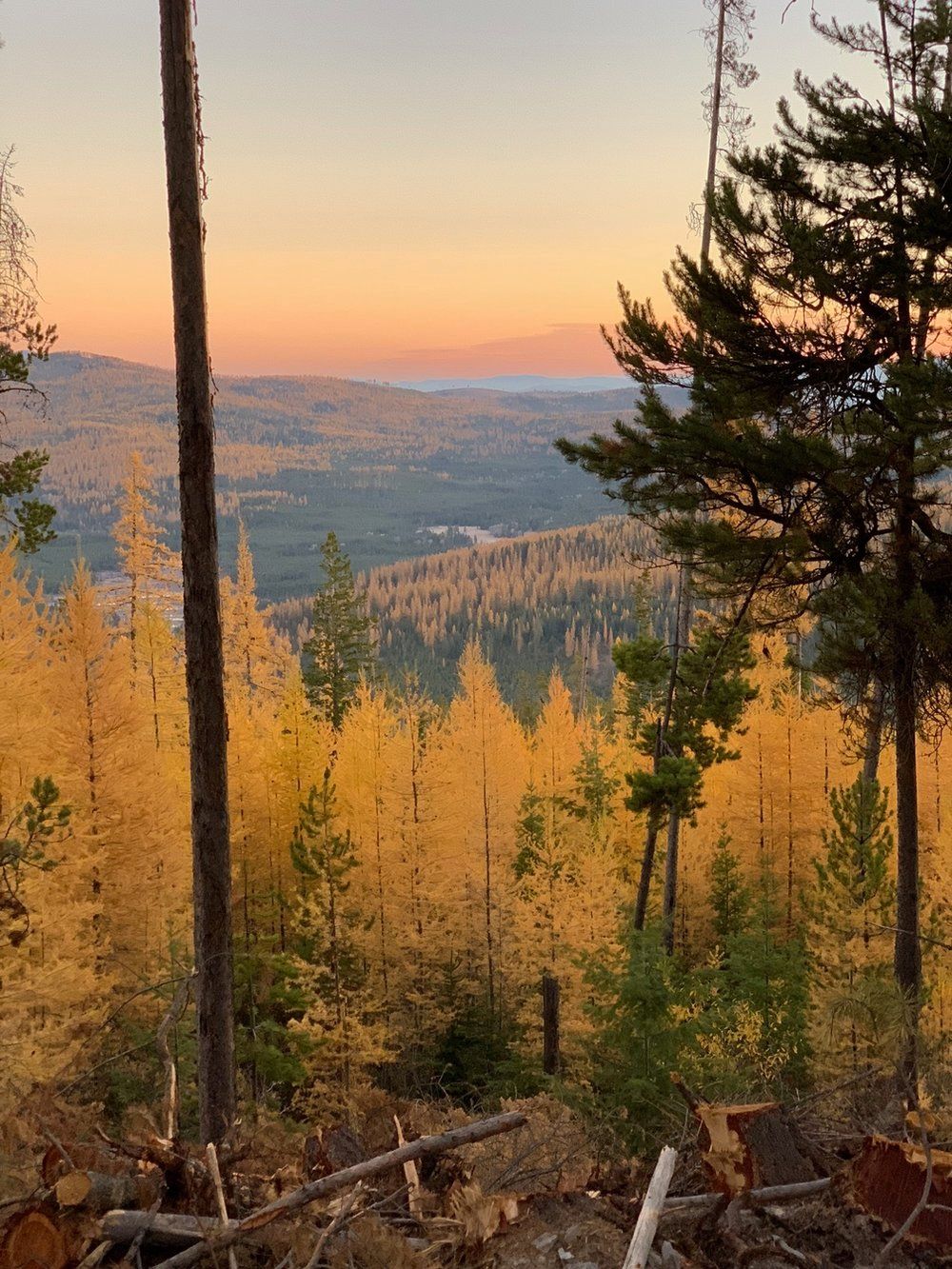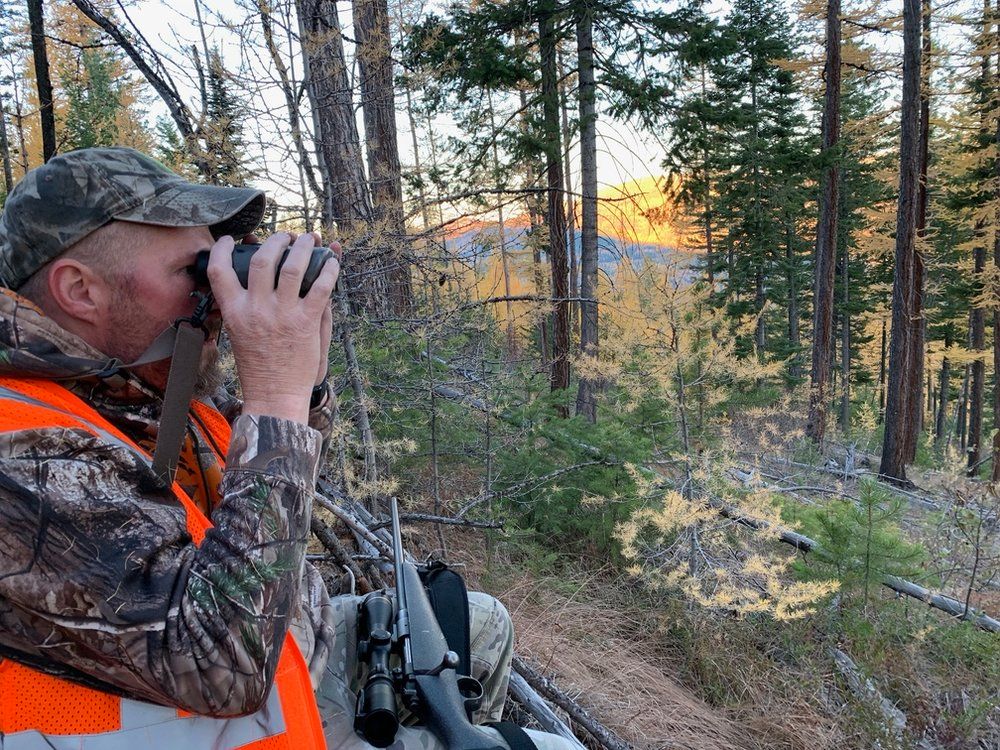I tremendously enjoyed my hunting trip to Montana last year. Hanging out with Eric Pfleger and his family, slipping through the woods, and shooting a buck made for a fantastic experience. Even before I headed home, I had resolved to come back and do it again.
While I put in for another out of state Elk/Deer combo tag this year, I didn’t get drawn. Eric suggested that I put in for an antelope tag. Unlike the statewide big game combo tag, the lope tags are for particular hunting zones. Eric has an area in central Montana where he’s hunted several times and was planning to put in for again this year, so I put in for tags there. I got drawn, as did Eric’s wife, Linda. Eric, however, did not (probably all those out of staters coming in and hunting in Montana). He did have second, special elk tag that was good for the area where we’d be hunting, so he and his young son went out there the week before to get camp set up and do a little elk hunting.
There’s a week between the end of the deer/elk archery season and the start of deer/elk firearm season that Eric likes to use to go out and hunt antelope. I arranged to fly out to Montana and hunt that week. The timing worked pretty well for me since it would be after I moved to a new apartment the first week of October. That did create some challenges as far as keeping track of all my gear during the move, however.
Gear
My primary rifle for this trip was my Ruger Precision Rifle in 6.5 Creedmoor. This is a pretty long, heavy gun, but according to Eric, antelope hunting out in the wide-open areas of central Montana is sort of sniper-ish anyway, so it seemed like it would suit. For field use, I’m very glad that I decided to replace the factory stock with a Magpul PRS stock, which has much less to catch on vegetation and such. This rifle has a Vortex 3-18x scope (also quite heavy), and I’m running an AAC 762-SDN6 suppressor.
My main load for this rifle uses Berger target bullets, which aren’t all that suitable for hunting. Instead, I worked up a load using Barnes LRX. This basically gives up some external ballistics (the ballistic coefficient isn’t as high) in return for better terminal ballistics. They’re very tough and are supposed to expand well.
Initially, I was only going to bring a 9mm Glock for “social purposes,” as Eric indicated that this area wasn’t really grizzly country. However, the day before I left Linda texted me with a story about a grizzly killing a calf just west of where we’d be hunting. I decided to throw a 10mm and some 220-grain hard cast ammo on board as well. For both pistols I brought along Safariland holsters that are dropped and offset to clear a pack belt. I had some CCW holsters as for use around camp too.
Knowing that the weather in Montana in October can be quite variable, I packed a couple pairs of long underwear, fleeces, gore-tex, and gaiters. I also brought many pairs of gloves, including a nice new pair of Outdoor Research Convoy waterproof insulated gloves that I hoped would help do a better job of keeping my fingers warm than the thin glove plus flip open mitten setup I’d used the previous year (though I brought that as well). I also brought along a pair of gardening gloves for crawling. My Eberlestock Halftrack pack would carry all this kit.
If this sounds like a rather lot of stuff to fly with, it is. I shipped Eric and Linda a box of gear ahead of time with my pack and some of the warm clothes. This both lessened the amount of stuff I had to fly with and got one box out of my hair during my move.
The rest of the stuff fit in a big rolling suitcase, a large rifle case, a carry-on duffel bag and a small backpack with some room to spare (and weight to spare for the checked bags). I was able to keep track of almost everything that needed to come on the trip during the move. The only things I couldn’t locate as I was packing were a set of add-on lenses for my iPhone camera.
Saturday
I loaded up my bags and headed to the airport with plenty of time to spare. Checking the guns went smoothly, and my flight to Denver got in early. I was able to get some lunch in Denver without hurrying too much. As it turns out I needn’t have hurried at all since the Denver to Missoula flight was delayed.
Linda picked me up from the Missoula airport after my delayed arrival. After hitting Costco for some last minute supplies, we headed out to central Montana. We didn’t see any antelope on the drive, which I gathered from Linda was unusual. I hoped this wasn’t a portent of how our hunt would go.
The drive was about 3 hours (Montana is a big state), so it was late by the time we got into camp. We saw some snow up on the north-facing hillsides as we went through the mountains and we got a couple of flurries. During our last fuel stop, the temperature had dropped considerably.
When we hit camp, Eric had some nice, hot soup ready for us. Camp was two big tents, both with vestibules. The main tent, where Eric and family slept, was a Cabela’s Big Horn 3 with a wood stove to keep everything toasty warm. No wood stove in my tent, but he had a long cot and a warm sleeping bag for me.
We all sat up talking in the heated tent for a bit before turning in. It was cold enough I ended up double bagging it using both the bag Eric provided and the one I brought. Combined with some fleece and merino wool long underwear that kept me warm enough, except for my toes. The foot of the bag was up against the wall of the tent, which I think contributed to the problem. The next day I shifted things around so my feet wouldn’t be right up against the tent fabric and that (combined with warmer temperatures) prevented any more issues.
Sunday
We all slept in a bit on Sunday morning. It was pretty brisk out at sunup, so waiting for it to warm up a bit was quite welcome. Eric took his bird hunting shotgun down to the river to see if he could flush any ducks, but Bridger (Eric’s bird dog) flushed the only bird they saw too far away for him to take a shot.
We had a hearty breakfast (oatmeal and sausages) and started getting our gear together to go hunt antelope. I’d had to pull my pack apart and completely unload it to get it to fit in the shipping box, so I had some work to do to get ready.
It was late morning when we headed out. We drove just down the road to a Hutterite colony where Eric had permission to hunt on some of their land. The area was rolling terrain, where you could see for miles, but there might be a whole herd out of view in a draw a hundred yards away.

Driving into the colony, we saw a small herd of antelope running off in the distance. Then further in we saw another small herd, much closer. We got geared up for a stalk. Since I figured we’d be crawling, I went light and didn’t bring my pack, just stuffing the essentials (water, rangefinder, binos, etc.) in my pockets. Eric took a large Maxpedition messenger-type bag. He and I started moving in towards where we’d seen the antelope.
With the very barren terrain (either hay stubble or short sage vegetation) the process actually reminded me of CQB, using the angles to your advantage to conceal yourself from the antelope as much as possible. This is where skill at reading micro-terrain really pays off.
As we were moving up on the herd we were working, we spotted a third group, further from the road. The terrain to move towards this new group was more favorable, so we crossed a barbed wire fence and worked our way up a drainage towards them. They moved off over a small rise, but as we got closer, we spotted them again.
Pretty soon we were crawling on hands and knees to avoid being spotted, then down to belly crawling to stay out of their line of sight. We found the lope bedded down at about 300 yards. There was one nice buck in the group, he was laying with his rear towards us. The wind was strong and gusty, making for difficult shooting. I waited for a lull, but a gust came up just as I pressed the shot. The whole herd sprang up and bounded off. No sight of any injury to the buck, so it was a clean miss.
After the lope crossed a distant ridgeline, Eric and I took a peek down in the depression where they’d been bedded down, then walked back to the truck.
From the truck, we used our binoculars to glass another herd far off but decided they were too distant. Instead, we drove to some nearby Block Management Areas. BMAs are private land where the landowner gives hunters permission to hunt on their property in return of a share of the money from hunting licenses (based on how many hunters sign in using a box at the entrance to their BMA). We drove up a road with several BMAs and pieces of state land along it to take a look.
There was a nice herd with a big fat doe, but it was just on the wrong side of the property line on land that wasn’t part of the BMA. Most of the BMAs and state land were much flatter than the terrain on the colony, making any stalking a more challenging proposition (Eric did a 500-yard stalk on one of these plots a few years ago).
We headed back to camp and finished off with some tasty chili and beer. While I was a bit frustrated with my miss, it was a good day of hunting.
Monday
After another nice warm breakfast of oatmeal, we loaded up the truck and headed down to the colony again. This time we spotted a small group of antelope not too far from the road just as we came in. The terrain wasn’t very conducive for stalking closer from this side, so we drove around to the other side of the ridge they were on, hoping to approach them from that side. We geared up and stalked over the ridge, only to find the lope had moved off.
Returning to the truck, we drove down the main dirt road in the colony, stopping periodically to glass the prairie for more lope. We saw a large herd back to the west. It was on a part of the colony that we weren’t allowed to hunt (they’d leased it out exclusively to an outfitter for his paying customers).
The members of the colony were rounding up cattle in the next field over and moving them into the area where we were hunting. All this activity seemed to have run off all the antelope, as we didn’t see any more on the land we were allowed to hunt.
Instead, we decided to drive up and take a look at some more Block Management Areas and state land further east. On the way, we drove into Harlowton (the nearest reasonably sized town). Eric hit the post office, and we stopped at a gas station where they also have an attached ranch supply type store with western wear, camping gear, guns, and other supplies (I get an odd sort of joy shopping at places that sell alcohol, tobacco, and firearms under one roof). We grabbed some lunch and a few supplies for camp before heading out.
We did a big loop up towards the Little Belt mountains, taking a look at half a dozen Block Management Areas and some parcels of state land. We didn’t see any antelope. Some of the BMAs near the Little Belts were getting into more rugged, heavily treed terrain that wasn’t great lope habitat but would be good prospects for elk if Eric came back a bit later in the season to fill his special elk tag.
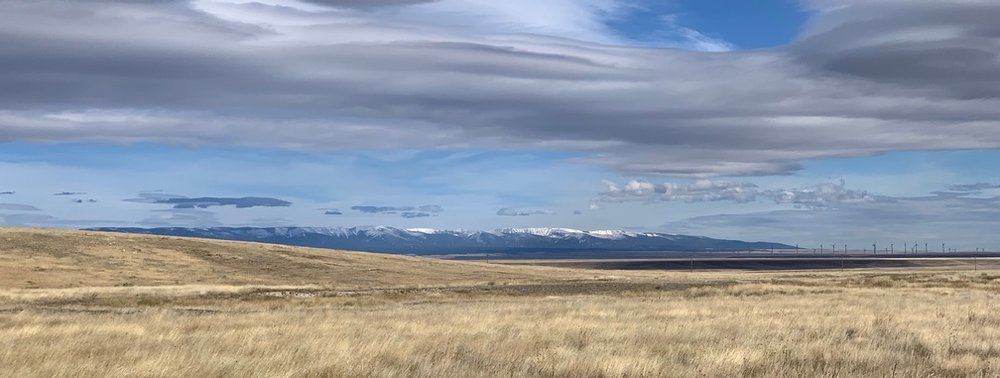
Heading back to the colony, we saw a small herd quite a ways from the road. We geared up and headed out to move up on them. As we got close, I spotted one of the does looking right at us over the top of a hill (I’ve got about a foot of height on Eric or Linda, so I often spotted lope first when we were on foot). We dropped down and crawled closer. Before we had a chance to shoot the herd ran off. I might have had a shot, but I couldn’t pick out any bucks in the herd, so I held my fire.
We watched them for a while as they moved off at what was, for them, a slow trot (a pace at which they’d probably outrun top athletes). Even after they slowed down to more of a saunter, they seemed to stay fairly mobile. Rather than putting on a ton of miles trying to get closer to moving antelope, we headed back to camp.
On the way into the campground Eric spotted three moose across the river, including a massive old bull with a huge rack. We pulled out the binoculars and watched them for a bit. In Montana, a moose tag is something you might put in for every year and only get after ten or twenty years. If Eric ever draws one, this might be a good region to come back to fill it.
We changed clothes and headed into White Sulphur Springs, the next town to the west. The eponymous springs have been turned into a motel with hot water pools. After a couple of days of chilly temperatures and vigorous physical activity (and no showers), it felt great to relax in the hot water. We spent over an hour soaking in the pools before heading over to a local eatery, Bar 47, for nachos, burgers, and beer.
It was very late by the time we got back to camp, so we turned in straight away.
Tuesday
After the late night last night, we slept in a bit (no bird hunting walk for Eric this morning). We had some breakfast and headed out to the colony, as usual. On the way in we saw a few pairs of antelope before coming on to a big herd fairly close in. A bit too close, as it turned out since they moved off after they saw the truck.
We drove up to a high point near the end of the road and watched them as they moved off. They eventually headed over a short rise into a depression where we couldn’t see. However, after waiting for a while we didn’t see them emerge further away, or to the right or left, up or down the depression, so we figured they must still be in there. We decided to walk out and have a look.
Linda and I geared up and headed out first, with Eric and his son following a ways behind. It was a good, long walk out to the ridge they popped over, all the way out past the barbed wire fence Eric and I had crossed on Sunday.
I spotted a few members of the herd on the other side of the rise where they disappeared, confirming they were still there. We couldn’t see much (or shoot) from this distance, so we picked out a patch of tall grass about a hundred yards further forward as our observation point and got down on hands and knees to crawl closer. Eventually, we were belly crawling, but when we got up to the grass, we were able to get a look at some of the herd.
The grass was too high for me to get a shot from prone but too short for a taller position like sitting. Though I was afraid I might spook them, I crawled closer. This was all very slow sniper crawling, shoving the rifle forward with one hand, then pushing with your feet and sliding your belly along the ground with your arms to move forward six inches at a time. Several times I paused and raised my rifle to see if I could get a shot, but the grass was still too high.
Eventually, I was able to get a good enough view through my scope to take a shot. At this point, we were about 300 yards away. I picked out a good looking buck and Linda set up about 5 yards away to take a doe if she still had a shot after I shot the buck. The wind was strong but less gusty than Sunday. I held off for the wind and pressed the shot. Another miss.
The herd sprang up and ran. Linda didn’t have a shot at a doe either. Most of the herd headed off up the draw to our right. A few headed away from us, including a decent looking buck. He ran partway up the butte, stopping broadside to us about 500 yards away. I was hesitant after two misses, but Eric encouraged me to take the shot.
I held just behind the buck’s tail for windage and loosed another round. The buck dropped like a rock.
We watched the rest of the herd run off some more. I used my rangefinder to lase the spot where the buck dropped. It came out at 516 yards. Eric and his son headed back to the truck, while Linda and I walked out to my buck.
I’d hit it in the neck near the base of the head, accounting for how quickly it dropped. That also tells you how windy it was, since I’d held just behind the rear end and the bullet had drifted the entire length of the animal, probably more than 4 feet.
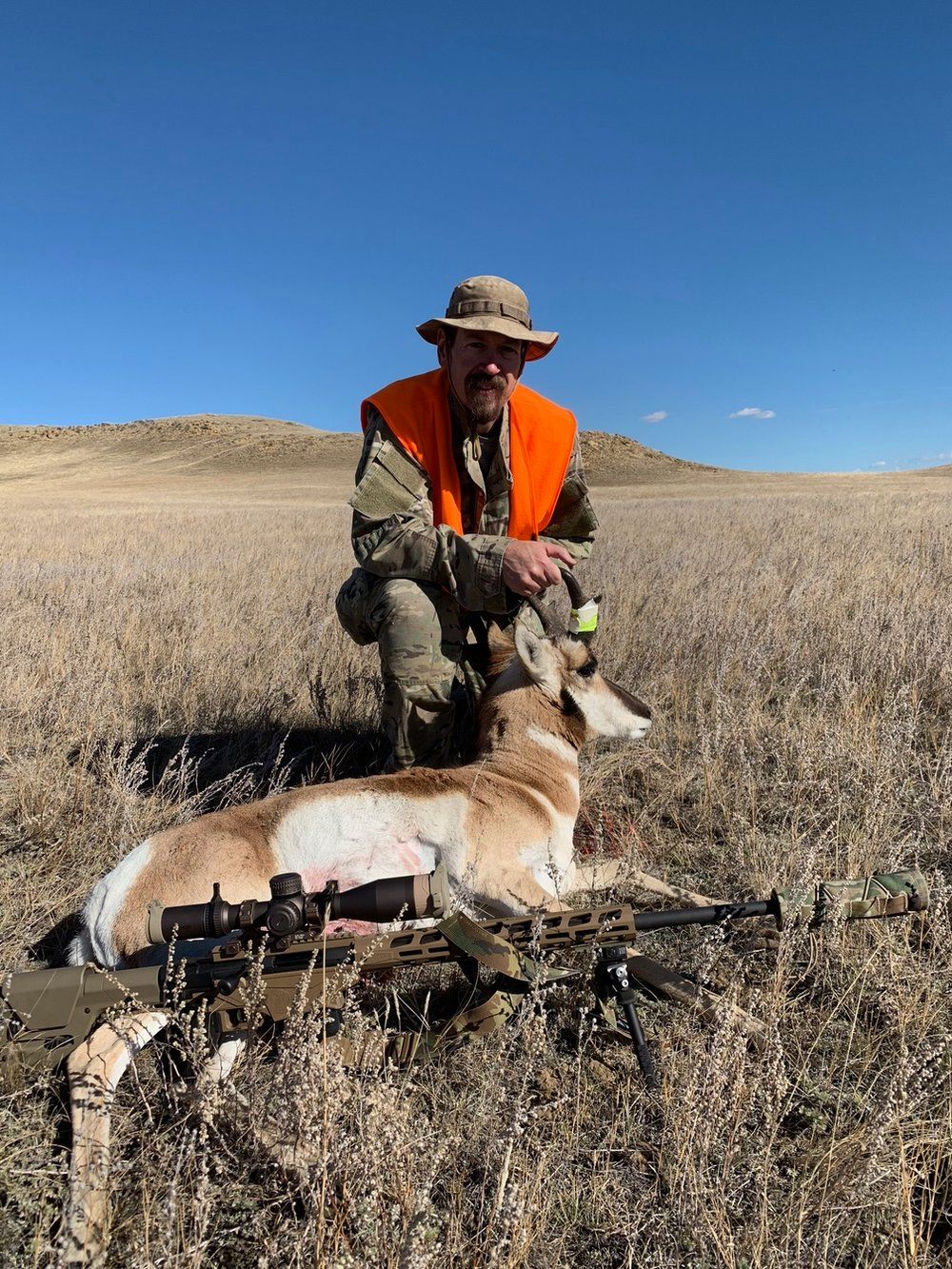
We got some pictures of the buck, including me with the trophy, then set about the process of gutting it. With some help from Linda, I remembered enough from my experience gutting the deer I shot last year to get him opened up and get the guts out. Eric arrived with the truck just as we finished gutting. Once we had everything packed up, we drove back to the road.
On our way out of the colony, we came on a small group of lope that ran off when I hit the buck. Linda hopped out and took a shot from the hood of the truck, but her round impacted short.
We headed back to camp and got to work butchering the buck I shot. It was warm enough that it was important to get the animal broken down into quarters and deboned so it would cool off and not spoil. Eric had Linda and I do the work, starting with caping the animal (removing the hide). Last year I’d had my deer hide tanned. I liked how that came out (it’s currently sitting on my couch). Eric said that antelope fur tends to come off leaving a tanned hide very mangy looking, so I opted not to save it. This meant we could be a bit more aggressive getting it off, but it still took quite a while.
Eric was sure right about the hair coming off the hide, that stuff got everywhere while we were caping the animal. As we broke it down into quarters, we spent quite a bit of time trying to get it off, since you don’t want that on your steak or in your burger. We did as much as we could, but doing a really decent job would have to wait until we got home and could wash the meat off. Next, we deboned the quarters, since that would help pull the heat out of the meat. Finally, we cleaned the remaining meat off of the rib cage and spine, to be ground into antelope burger. Using a bow saw we took off the head for a European mount (bare skull with horns).
This process took the rest of the afternoon. While Linda and I were finishing up, Eric put together some tacos for a tasty dinner. We followed this with some celebratory liquor (Templeton Rye) and a game of Sneaky Snacky Squirrels.
Wednesday
We got going considerably earlier this morning than we had previous days. Heading out to the colony, we drove down to the end of the dirt road and spotted a big herd of antelope off near the base of the butte where I’d shot my buck. We glassed them for a bit and planned out a stalk.
As we drove back down the hill to where we’d planned to start our stalk we encountered four antelope, who ran off a ways. Linda and Eric jumped out to see if they could get a shot on them, but no joy. They trotted off and joined up with the others that we’d seen earlier.
Rather than riling them up further, we decided to leave them be for a bit and go check out the Block Management Area where we’d spotted the herd on the wrong side of the property line on Sunday. Today, however, we did not see any lope out there.
Instead, we headed out to a big ranch that allows hunting but requires you to sign-in in person. Unfortunately, we found the sign in place was closed on Wednesdays. Despite this, we drove through the ranch to take a look and to see if there were any antelope on some parcels of state land that were interspersed with the private property.
Down at the end of this road, the road climbs up into the foothills of the Little Belt Mountains and crosses into National Forest. There’s a campground out there that would be another good spot for Eric to try to fill his special elk tag later this year.
Hoping the big herd had settled down a bit, we headed back to the colony. Driving down the dirt road, we came across a small group at relatively close range. Linda bailed out and took a shot from the hood of the truck, but didn’t get a hit. The group ran off.
We drove out to the end of the dirt road without seeing any more antelope. After that last shot, Linda wanted to confirm zero on her rifle. Eric set up a target at 300 yards (her zero distance), and they did a test fire (it was within 2”).
Even though we couldn’t see any lope, we decided to walk out and take a look at the broad draw where the herd and been bedded down on Tuesday before I shot mine. The herd we saw this morning had been wandering out that way when we last saw them and the ones that Linda took a shot at had run off that direction too, so we figured they might still be there. Linda and I geared up and walked out there, while Eric stayed back at the truck with his son. Since I’d filled my tag, I didn’t bring my rifle, just a pistol, some binos, and a laser rangefinder.
The stalk was complete deja vu from the day before. We parked the truck in the same place, walked down the hill on pretty much the same route, crossed the fence in the same place, and spotted the first members of the herd from about the same spot.
Linda dumped her pack, and we crouched down out of their view and moved closer. As we closed in, we dropped down to hands and knees, then shifted to belly crawling as we closed in. I saw places where we’d scraped up the ground crawling in the day before, and I even ran across one of my spent shell casings that I hadn’t been able to recover the previous day. We were in exactly the same spot.
During the stalk in I was even more nervous than the last time we did this stalk. As much as I hadn’t wanted to blow my own shot at a lope, I really didn’t want to blow Linda’s stalk.
We got up to a point with a good view of part of the herd. I very carefully raised myself up clear of the grass so I could lase them with my rangefinder and got a range right at 300 yards. Linda told me which nice fat doe she was going to shoot at and I got on target with my binoculars to spot for her.
She took the shot and missed just a hair over the doe’s back. The herd got up and ran, but not nearly as far as they had the day before. One group sort of circled around and stopped about 300 yards from us. Linda picked out another big doe and took the shot. This time it dropped like a rock right there.
After about a minute the doe started whipping its head up and flailing around with its front legs, but it didn’t seem to be able to get up. Linda stayed on target while I went back and retrieved her pack. We closed in on the downed doe and saw it was still alive, though not kicking around as much as it had been earlier. Linda stepped up and shot it in the neck, which took care of things.
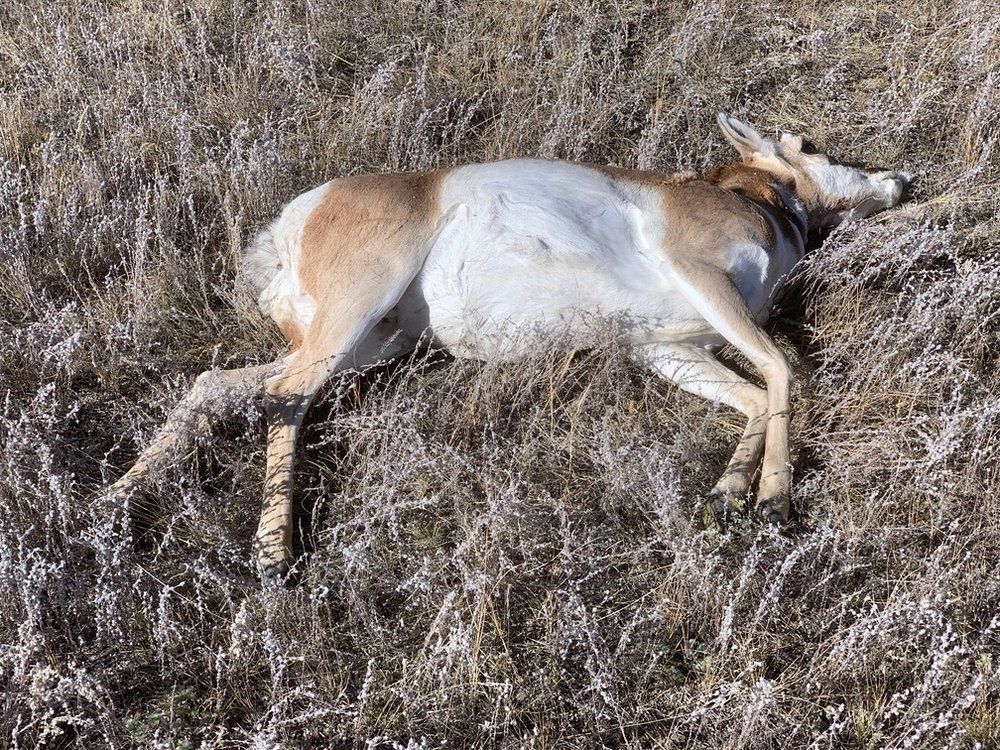
After getting some photos, Linda gutted the doe. Once its guts were out, we rigged up some paracord to the legs to help us drag it. The mercy shot to the neck complicated things a bit since it had completely severed the spine, leaving he head loosely attached. Linda wasn’t going to have it mounted or anything, but we decided having it tear off as we were dragging would be a bit too macabre. I trussed it up with some paracord to help keep it off the ground, and since I’m taller than Linda, I carried the head end.
We dragged it about 500 yards to the fence, where Linda was able to get service on her cell phone and text Eric to drive down and pick us up. We loaded up the doe and headed back to camp.
It was after 3:00 at this point, and to speed things up, Eric went ahead and caped the lope. He was able to get it done in about 1/10th the time it took Linda and I the day before (and spread a lot less hair around to boot). I guess that’s the benefit of having done this hundreds of times rather than two.
Linda and I quartered the lope and got the bones out. While we were working on this, a friend of ours who goes by Colonel Plink on the Paragon Pride forum pulled in to camp. He and his girlfriend were out hunting antelope, and earlier Eric had texted them the location of our camp. They were planning on going into White Sulphur Springs to get some dinner and soak at the hot springs. We decided we would join them after we were done butchering the lope.
We got everything deboned. Rather than pick the ribcage clean like we did with my lope, we decided to break it down into racks and throw those in the cooler whole.
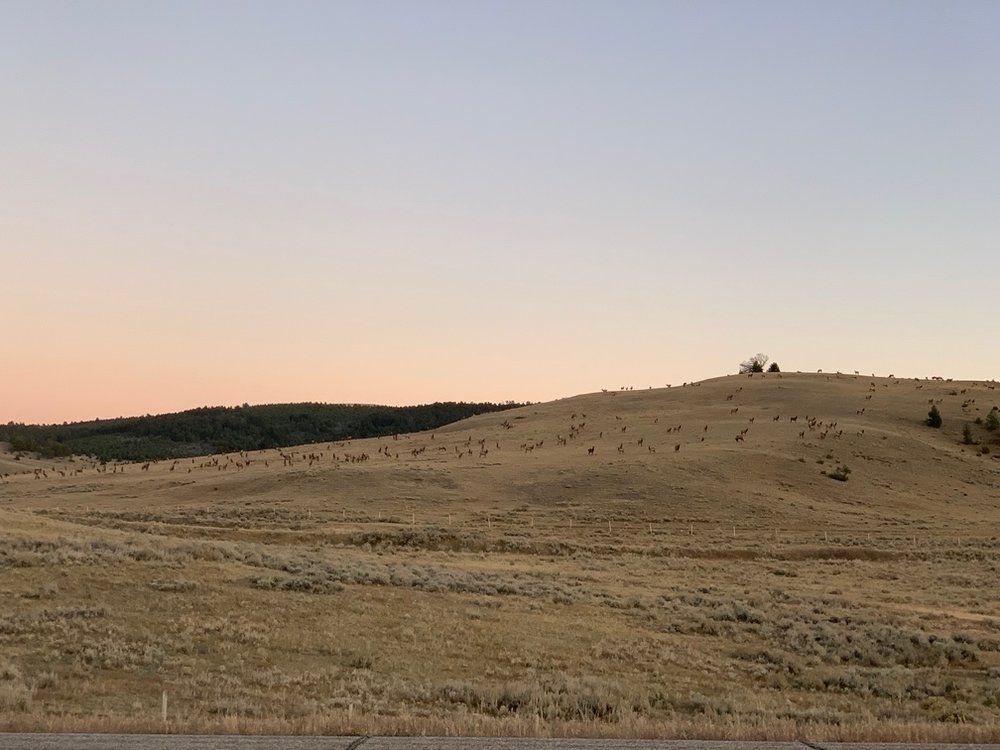
On the drive into While Sulphur Springs we saw an enormous herd of 100 plus elk on a hillside outside of town. There were several big, impressive bulls and we got to see a couple of them lock antlers (though the rut was over by this point). They were quite vocal, calling to each other and making a lot of noise. It was awe-inspiring and majestic, a real treat.
In White Sulphur Springs we had dinner at the Stockman’s Bar, where we had some excellent burgers and good bread. Afterward, we headed over to the hot springs and met up with Colonel Plink. Tonight the warm pool was significantly warmer than it had been on our previous trip, nice and toasty. We spent about an hour there, soaking our aching muscles and enjoying some good conversation.
We headed back to camp and turned in.
Thursday
Since both Linda and I filled our tags, we decided to head back to Eric’s place where we could finish processing the antelope into steaks and maybe get out to hunt some birds or bear and, starting Saturday, deer and elk.
Tearing down camp was a bit of an operation. Eric and Linda had brought out plenty of kit and supplies, including food for the entire week. Getting it all back in the pickup and the suburban was a bit of a tight fit. By the time we tore down the tents, got everything packed up, and loaded it into the vehicles it was early afternoon. We headed out, making a late afternoon stop in Helena for a great dinner at the Brewhouse Pub & Grille.
President Trump held a rally in Missoula that day (we saw Air Force One sitting at the airport as we drove by) so there was a lot more traffic headed out of town than usual for a Wednesday night. We got to Eric’s place around 9 o’clock and only unloaded the most vital stuff, leaving the vast majority of gear until tomorrow.
Eric and Linda had just moved into this place in September, and there were still plenty of boxes waiting to be unpacked. We cleared some space amid Eric’s gun-related gear for an air mattress for me to sleep on. After a drink and some hanging out, we turned in for the night.
Friday
Friday morning I helped Eric unload gear from the vehicles. In the afternoon Linda and I turned the deboned quarters from our antelope into steaks and roasts while Eric continued the unloading process.
Through the use of copious amounts of water, we managed to wash off most of the hair that had troubled us out in camp. Linda did the trimming, and I sliced the trimmed meat into steaks. As a token of my gratitude after my hunt up in Montana last year I bought Eric and Linda a nice meat slicing knife and I got to use that to slice up the antelope. We got some really nice steaks out of them. Being smaller animals, many of the cuts were more like medallions than full-sized steaks, but I’m sure they’ll be equally tasty.
It took long enough to finish butchering the antelope quarters that we decided to eschew an evening hunt. Instead, Eric drove around showing me a bit of the local area, including one of the areas he planned to use for some of the Longrifle/Rural Scout Sniper class he’d be teaching in May.
Eric had some venison marinating all afternoon, and when we got back, he threw it on the grill. Along with some mashed potatoes this made for a delicious dinner.
Saturday
Saturday was opening day of rifle season for deer and elk. I was a bit leery to go into the woods on a day when the yahoos would be out in force, but Eric persuaded me that we could get far enough back in the woods that it wouldn’t be a problem. He and I got up at 5:30, grabbed some breakfast, and headed out around 6:20.
After about a 20 minute drive we were at a forest service gate closing off a side road up in the mountains. From there we stepped off and hiked in a couple of miles to a spot where the road made a sharp switchback. The tamarack were just turning gold and the views in the morning light were pretty fantastic.
We walked a bit beyond the switchback to a spot with some excellent views down into a bowl below. This would give some good shooting opportunities should an animal come along. It also provided a look at the area where Eric would be teaching days 3 and 4 of the Longrifle/Rural Scout Sniper class next May.
